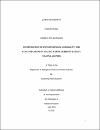INVESTIGATION OF SPATIOTEMPORAL VARIABILITY AND CONTAMINATION OF PLASTIC MARINE DEBRIS IN QATAR’S COASTAL WATERS
Abstract
There has been a tremendous proliferation in plastic production in the last five decades due to its low cost and versatile applications. Plastic debris dominates the marine litter globally and has been found in the most pristine environment including the abysmal region of the ocean. Studies show that over 8 million tons of plastics are dumped in the ocean annually. Plastics are persistent in the environment and take several decades to degrade especially in the ocean. Large plastic debris can destroy the coral reefs and may cause entanglement, choking, blockage of digestive tracts when ingested by turtles, whales, sharks etc, causing several thousand deaths annually among these organisms. Microplastics are tiny plastic particles that seldom originate from fragmentation of large plastic debris or are produced to serve some specific purposes. Microplastics pose greater threats as they can be mistaken for food by filter-feeders and planktivorous fish, and can also adsorb large quantities of recalcitrant organic pollutants (OPs) which biomagnify up the marine food web, hence, explains the need for their investigation. In the first phase of this study, the spatial and temporal distribution of microplastics was investigated in sediments and seawater respectively. Eight beaches across Qatar and four sea surface stations were surveyed between the months of December 2014 and March 2015. Microplastics were discovered in all samples and their abundance varied both in intertidal sandy beaches and sea surface. Since plastic debris are hydrophobic and easily adsorb organic pollutants the second phase of this study was targeted at investigating the concentration of PCBs and PAHs adsorbed on macroplastics in situ. Results showed that approximately all macroplastics analyzed were contaminated with PCBs and PAHs. Large piece-to-piece variations of contamination up to two orders of magnitude were discovered within sites (2 to 1,005 ng/g), although there was no significant difference in contaminant concentration among all sites for PCBs and PAHs respectively. Lastly, a field adsorption/desorption experiment was performed to investigate how pellets of different polymers and contaminated with POPs behave when placed in ambient seawater. Pellets were deployed and later retrieved at 48h, 96 h, 192 h, and 312 h respectively. The pellets were analyzed for PCBs and PAHs and undeployed pellets were also analyzed at time 0. Adsorbed PCBs and PAHs concentration showed a steady decrease with time, suggesting that contaminated pellets ending in the marine environment release their adsorbed contaminants in less contaminated seawaters revealing a complex OPs dynamic between plastics an seawater as a function of differential concentrations of pollutants. This study is the first of its kind in Qatar and seemingly in the entire Arabian Gulf region. Marine pollution is a growing concern in Qatar coastal and offshore environment. Marine debris is of major concern due to the fact that plastic can take several decades to be fully degraded. Results from this study indicate that microplastics are ubiquitous and the fact that they are easily mistaken for food and ingested by zooplankton and smaller fishes makes them a serious threat to the marine food web. Hence, a study on the spatiotemporal distribution of microplastics is crucial in investigating the size and polymeric properties of marine debris to give policy makers an insight of the sources of the debris and proffer suggestions on how to tackle the menace using a holistic approach.
DOI/handle
http://hdl.handle.net/10576/3907Collections
- Biological & Environmental Sciences [102 items ]


